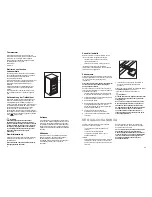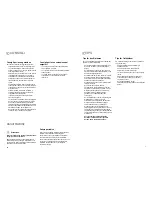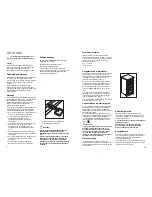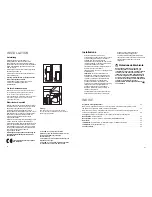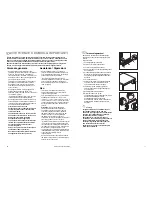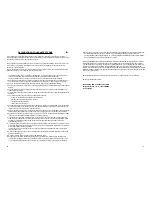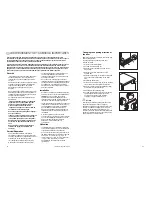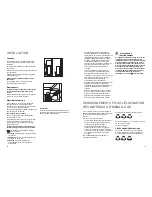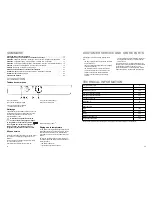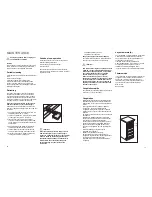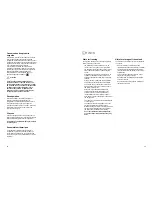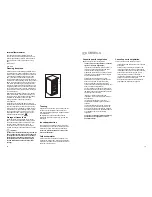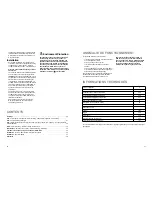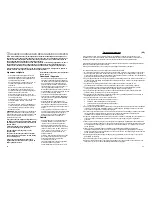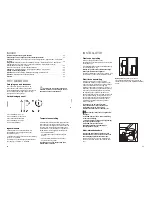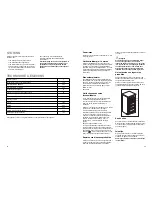
6. Mettez lÕappareil en rŽgime de congŽlation
rapide. Apr•s 2-3 heures de fonctionnement
lÕappareil est ˆ nouveau pr•t ˆ la conservation
des produits surgelŽs.
Important:
Pour cette opŽration nÕutilisez jamais dÕobjet
mŽtallique qui risquerait de dŽtŽriorer lÕappareil.
NÕutilisez jamais de dispositifs mŽcaniques ou
autres moyens artificiels pour accŽlŽrer le
dŽgivrage, ˆ part ceux prŽconisŽs.
LÕŽlŽvation de tempŽrature des denrŽes
congelŽes peut diminuer leur durŽe de
conservation.
20
DŽgivrage
Dans le congŽlateur, par contre, il faut Žliminer le
givre ˆ chaque fois qu'il y a une couche Žpaisse qui
s'est formŽe (de 4 mm environ), en se servant de la
spatule en plastique qui est livrŽe avec l'appareil.
Pendant que l'on effectue cette opŽration, il n'est
pas nŽcessaire de couper le courant ou d'enlever
les denrŽes qui se trouvent dans le compartiment.
Pour effectuer un dŽgivrage complet procŽdez de la
mani•re suivante:
1. tournez le bouton du thermostat sur la position
Ç
■
È ou dŽbranchez lÕappareil;
2. enveloppez les denrŽes dans plusieurs feuilles
de papier journal et conservez-les dans un
endroit frais;
3. maintenez la porte ouverte,utilisez la spatule
comme goutti•re et placez-la dans la partie
centrale, en bas, de lÕappareil, placez au-
dessous une cuvette pour recevoir lÕeau de
dŽgivrage.
4. Žpongez et sŽchez soigneusement les parois et
le fond; conservez la spatule pour toute utilisation
ultŽrieure.
5. ramenez le bouton du thermostat sur la position
dŽsirŽe ou rebranchez lÕappareil.
ENTRETIEN
DŽbranchez lÕappareil avant toute
opŽration.
Attention
Cet appareil contient des hydrocarbures dans son
circuit de rŽfrigŽration; lÕentretien et la recharge ne
doivent donc •tre effectuŽs que par du personnel
autorisŽ.
Nettoyage intŽrieur
N'utilisez jamais des objets mŽtalliques pour
nettoyer l'appareil; vous risquez de l'endommager.
A l'occasion d'un dŽgivrage complet, lavez I'intŽrieur
avec de l'eau ti•de et du bicarbonate, rincez et
sŽchez soigneusement.
Nettoyage extŽrieur
Lavez la carrosserie avec de l'eau ti•de
savonneuse. Passez de temps en temps un produit
ˆ polir. DŽpoussiŽrez le condenseur situŽ ˆ l'arri•re
de l'appareil ˆ l'aide d'une brosse ou d'un aspirateur.
Une accumulation de poussi•re risquerait de
diminuer le rendement de l'appareil.
Arr•t prolongŽ
Lorsque l'appareil doit rester ˆ l'arr•t pendant un
certain temps, prenez les prŽcautions suivantes:
dŽbranchez la prise de courant;
videz l'appareil;
dŽgivrez-le et nettoyez-le ˆ fond;
laissez les portes entrouvertes pour faire circuler de
l'air, de fa•on ˆ Žviter les mauvaises odeurs.
D068
41
The temperature alarm light (A)
The temperature alarm light turns on automatically
whenever the temperature within the freezer rises
above a certain value which might endanger
satisfactory long-term conservation.
It is perfectly normal for the temperature alarm light
to remain lit up for a short time after the freezer is
initially turned on. It will remain lit up until the
optimum temperature for the conservation of frozen
food is attained.
Cleaning the interior
Before using the appliance for the first time, wash
the interior and all internal accessories with luke-
warm water and some neutral soap so as to remove
the typical smell of a brand-new product, then dry
thoroughly.
Do not use detergents or abrasive
powders, as these will damage the finish.
This freezer compartment has been marked with
the symbol
, which means that it is
suited to the freezing of fresh foods, the
conservation of frozen foods and the production
of ice-cubes.
Starting
Insert the power supply plug into the nearest wall
socket (the function indicator light (A) will light up
indicating that the freezer is receiving electrical
input.)
Turn the thermostat knob (E) to the right to a
medium setting (the temperature alarm light (C) will
light up).
To turn off the freezer, turn the thermostat knob to
the ÇOÈ position.
Temperature regulation
The temperature is automatically regulated and can
be increased to achieve a higher temperature
(warmer) by rotating the thermostat knob toward
lower settings or reduced (colder) rotating the knob
towards higher settings.
However, the exact setting should be chosen
keeping in mind that the temperature inside the
refrigerator depends on:
USE
Control panel
A.
Temperature alarm light
B.
Quick-freezing indicator light
C.
N/S knob
D.
Function indicator light
E.
Thermostat knob
¥ room temperature;
¥ how often the door is opened;
¥ the quantity of food stored;
¥ location of appliance.
A medium setting is generally the most suitable.
Important
If the ambient temperature is high or the
appliance is fully loaded, and the appliance is
set to the lowest temperatures, it may run
continuously causing frost to form on the rear
wall. In this case the dial must be set to a higher
temperature to allow automatic defrosting and
therefore reduced energy consumption.
Fast freezing
To start fast-freezing food, press button (C). Pilot
light (B) will come on.

